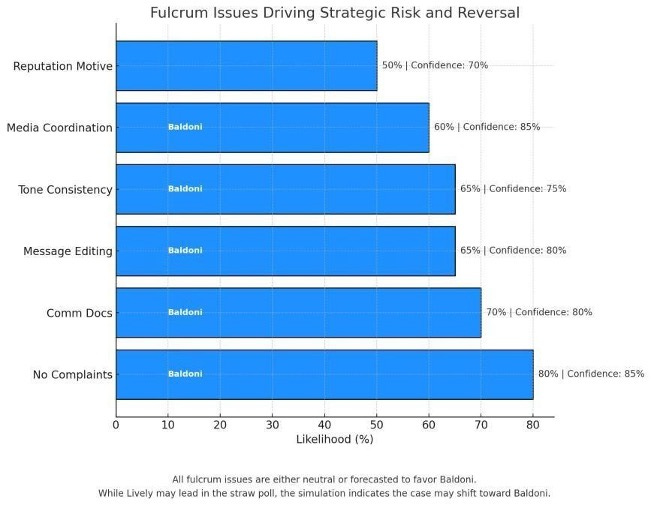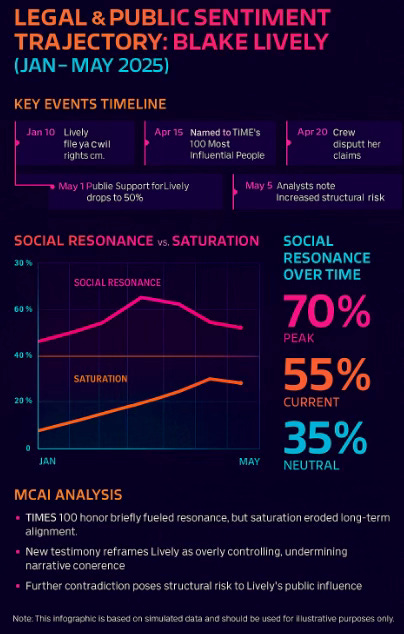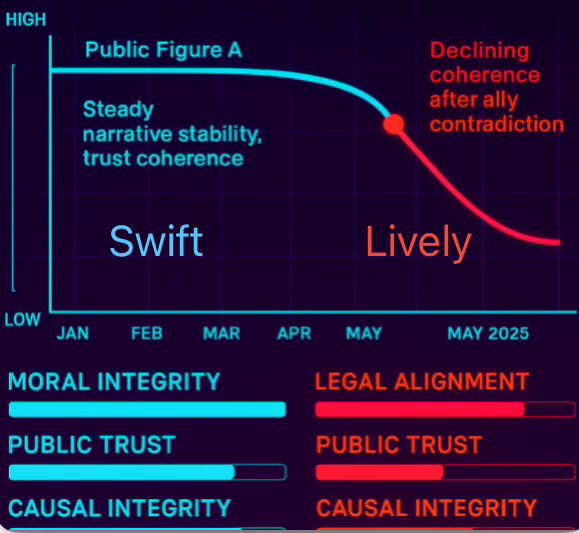MCAI Lex Vision: Lively vs Baldoni, Simulation-Forecast
The Court of the Judiciary and Public Opinion
This report uses MindCast AI’s Legal Vision framework to simulate the legal, reputational, narrative trajectories of Blake Lively and Justin Baldoni in their ongoing litigation. While Lively currently leads in public sentiment and procedural framing, the simulation identifies key fulcrum issues that could reverse momentum in Baldoni’s favor. Courts remain neutral but sensitive to discovery outcomes. MCAI forecasts pressure points before they appear in filings or headlines— supporting strategic foresight for legal and communications teams alike.
MCAI forecasts how legal narratives and reputational dynamics evolve. Its simulation engine uses Cognitive Digital Twins (CDTs) to model how stakeholders—such as courts, litigants, the media, and the public—react under legal and narrative pressure.
The Legal Vision module applies these simulations to disputes where facts and outcomes depend on tone, timing, and perception—not just precedent. Legal Vision proves most effective in cases involving balancing tests, fact-specific contexts, and narrative framing, such as:
Defamation
Contractuals
Antitrust
False advertising
Legal Vision doesn’t replace legal counsel. It strengthens legal and strategic foresight by identifying pressure points that influence outcomes—often before they appear in court.
How MCAI Supports Legal Case Analysis
MCAI improves legal strategy by identifying where a party’s behavior, tone, and legal position align— or conflict. CDTs simulate how each party performs under stress, while Legal Vision analyzes how courts and public opinion shift when new disclosures emerge.
This approach delivers predictive insight across:
Reputational drift when tone and action diverge
Privilege and defamation exposure based on sequence and motive
Media amplification risk
Judicial leanings shaped by timing and credibility
Public sentiment reversals tied to emotional coherence
Legal Vision translates these dynamics into forecasts—enabling lawyers, executives, and communications professionals to move ahead of potential breakdowns in legal or reputational integrity.
Overview of the Dispute and Current Standing
Blake Lively filed a formal complaint through the California Civil Rights Department in 2024, alleging hostile work conditions during the production of It Ends With Us. She cited tone-deaf conduct, emotional discomfort, and a lack of workplace protections.
Justin Baldoni and Wayfarer Studios countersued, alleging reputational sabotage, extortion, and deliberate narrative manipulation. They pointed to strategic press leaks and contradictory messaging. Media outlets, especially The New York Times, entered the discourse by amplifying Lively’s allegations pre-litigation.
As of this simulation:
Public opinion favors Lively, with an estimated 60–65% support (confidence: 85%)
Court sentiment slightly favors Lively’s position (confidence: 80%)
Both alignments may shift based on discovery
However, decisive legal issues may have a fulcrum dynamic, where the party who prevails on the issue may prevail in the case.
Legal Vision Forecast: Blake Lively
Lively gained early control of the narrative. Her tone aligned with gendered expectations of professionalism and emotional safety. Filing through the CRD formalized her legal standing and positioned her as the party seeking protection.
Likelihood of Lively prevailing: 55% (confidence: 80%):
Media coordination prior to CRD filing: 60% likelihood (confidence: 85%)
Selective editing of messages or emotional framing: 65% likelihood (confidence: 80%)
Reputational strategy driving internal actions: 50% likelihood (confidence: 70%)
If any two of these fulcrums activate through discovery, litigation privilege under California Civil Code §47 may no longer apply. That erosion undermines both her legal standing and public credibility.
Legal Vision Forecast: Justin Baldoni
Baldoni entered the dispute reactively but gained momentum. His tone matched prior public values—emotional authenticity, respect for gender equity, and ethical leadership. His communications and behavior before the dispute aligned with that narrative.
Likelihood of prevailing in countersuit: 50% (confidence: 75%):
Documentation of constructive communication: 70% likelihood (confidence: 80%)
Absence of corroborating misconduct claims: 80% likelihood (confidence: 85%)
Tone consistency under reputational pressure: 65% likelihood (confidence: 75%)
Baldoni’s strength depends on remaining consistent. If tone deviates or communications appear retaliatory, the integrity of his narrative may fracture. If Baldoni can avoid falling under the stress of litigation, he may prevail due to Faro issues being in his favor.
Legal Vision Forecast: The Court
The court CDT evaluates procedural fairness, timeline integrity, and application of law. It responds to contradictions, motive misalignment, and privilege risks—not media sentiment. The projections below are estimates at this time, before court determinations on the fulcrum issues.
Simulated outcomes:
Lively: 55% chance of success in original claims (confidence: 80%)
Baldoni/Wayfarer: 50% chance of success in defamation countersuit (confidence: 75%)
The New York Times: 65% chance of prevailing at motion-to-dismiss stage (confidence: 85%)
Key legal standards include:
Litigation privilege (Silberg v. Anderson, 50 Cal.3d 205)
Fair report and opinion doctrines
Actual malice threshold (New York Times Co. v. Sullivan, 376 U.S. 254) • Anti-SLAPP protections (California Code Civ. Proc. §425.16)
Any discovery revealing pre-filing narrative construction, motive-driven editing, or contradictions in legal sequence may shift judicial posture to favor Baldoni.
Legal Vision Forecast: Public Perception
The public CDT operates through System 1 logic—fast, emotional, and driven by perceived authenticity. Current sentiment favors Lively based on cultural pattern-matching and institutional amplification.
Current public sentiment:
Support for Lively: 60–65% (confidence: 85%)
Neutral cohort: ~25%
Support for Baldoni: ~10%
Simulated response to adverse discovery:
Lively drops to ~45% (confidence: 80%)
Neutral cohort rises to ~35%
Baldoni increases to ~20%
The public does not evaluate legal nuance. It tracks tone, trust, and betrayal. Should new information expose narrative manipulation, sentiment may pivot sharply.
Comparative CDT Assessment
Lively’s CDT holds early advantage through framing, tone, and procedural alignment. Her risk lies in losing privilege or appearing strategically reactive.
Baldoni’s CDT relies on emotional coherence and documentary evidence. He must avoid tone shifts that suggest counterattack rather than credibility defense.
Public CDT follows narrative flow. It trusts consistency and punishes surprise or contradiction. It reacts strongly to anything that signals reputation engineering.
Court CDT focuses on whether timing, evidence, and privilege meet legal thresholds. Discovery that undermines procedural posture will influence outcomes more than press cycles.
Each CDT remains active. Simulations update as new documents, media signals, or narrative reversals enter the record.
Conclusion
Legal Vision does not project outcomes. It identifies where risk emerges when evidence, tone, or motive break alignment. In Lively v. Baldoni, each party retains a viable path. Neither holds secure advantage. MCAI will continue monitoring developments in filings, media coverage, and discovery.
This report will update when new facts shift confidence in prevailing narratives or legal positioning.
Legal Vision equips leadership teams with foresight, not just hindsight. In narrative-driven litigation, that foresight often defines the result—well before judgment enters the record.
see updated MCAI coverage of the Lively case, June 2025.
MCAI Lex Vision: Update on Blake Lively vs. Justin Baldoni – What Just Happened (and Why It Matters)
Prior MCAI publication: Lively vs Baldoni, Simulation-Forecast, The Court of the Judiciary and Public Opinion
Images adjoining comments section







See Update on Blake Lively vs. Justin Baldoni – What Just Happened (and Why It Matters)
When speaking up meets legal power plays, whose story holds?
https://open.substack.com/pub/noelleesq/p/livelyupdate
The reputational terrain around Lively v. Baldoni has shifted meaningfully again. The most critical development has not been a court filing, but a narrative rupture—Taylor Swift, one of the most culturally trusted public figures, has signaled no awareness of the specifics behind Blake Lively’s claims, despite Lively’s previous implication of Swift’s presence. The Swift–Lively divergence has activated a new phase in the CDT simulation: ally contradiction under reputational pressure. With additional testimonies from crew members and extras suggesting professionalism on set, the contradiction is no longer isolated—it is becoming structurally damaging.
Comments on Taylor Swift
Swift’s posture in this controversy is not overtly adversarial. But her decision to withhold endorsement—especially when Lively invoked her name—speaks volumes in the language of public trust. Swift, who has built a brand on narrative clarity and emotional resonance, intuitively understands the cost of even implied misalignment. By opting out of the controversy, she preserves her integrity and implicitly signals to her audience that she will not co-sign reputational tactics that conflict with her principles. This silence has the effect of a surgical incision: it separates her from reputational entanglement without generating overt hostility.
Comments on Blake Lively
Blake Lively’s narrative architecture is now exposed to its most severe test. Her earlier public framing relied on moral elevation—TIME100, philanthropic accolades, cultural alignment with figures like Swift. But moral influence cannot be borrowed—it must be embodied. As Swift distances, and factual testimony contradicts Lively’s framing, the emotional coherence of her claimset collapses. The CDT now reflects high saturation, declining resonance, and fractured causal alignment. Without a structural recalibration—truthful reflection, factual grounding, or narrative restraint—Lively risks becoming a case study in symbolic capital overreach.
Conclusion
MindCast AI simulations now show that the litigation has evolved into a reputational referendum—not just on who is right, but on who remains coherent under scrutiny. Swift’s silence is not neutral—it functions as a trust signal in itself. And Lively’s insistence on symbolic elevation during a period of internal contradiction invites further narrative decay. The core lesson: in the age of cognitive simulation and public CDT feedback loops, moral coherence matters more than optics. The simulation has moved beyond the courtroom. It’s now unfolding in the minds of a watching public.
https://substack.com/@mindcastai/note/c-115958811